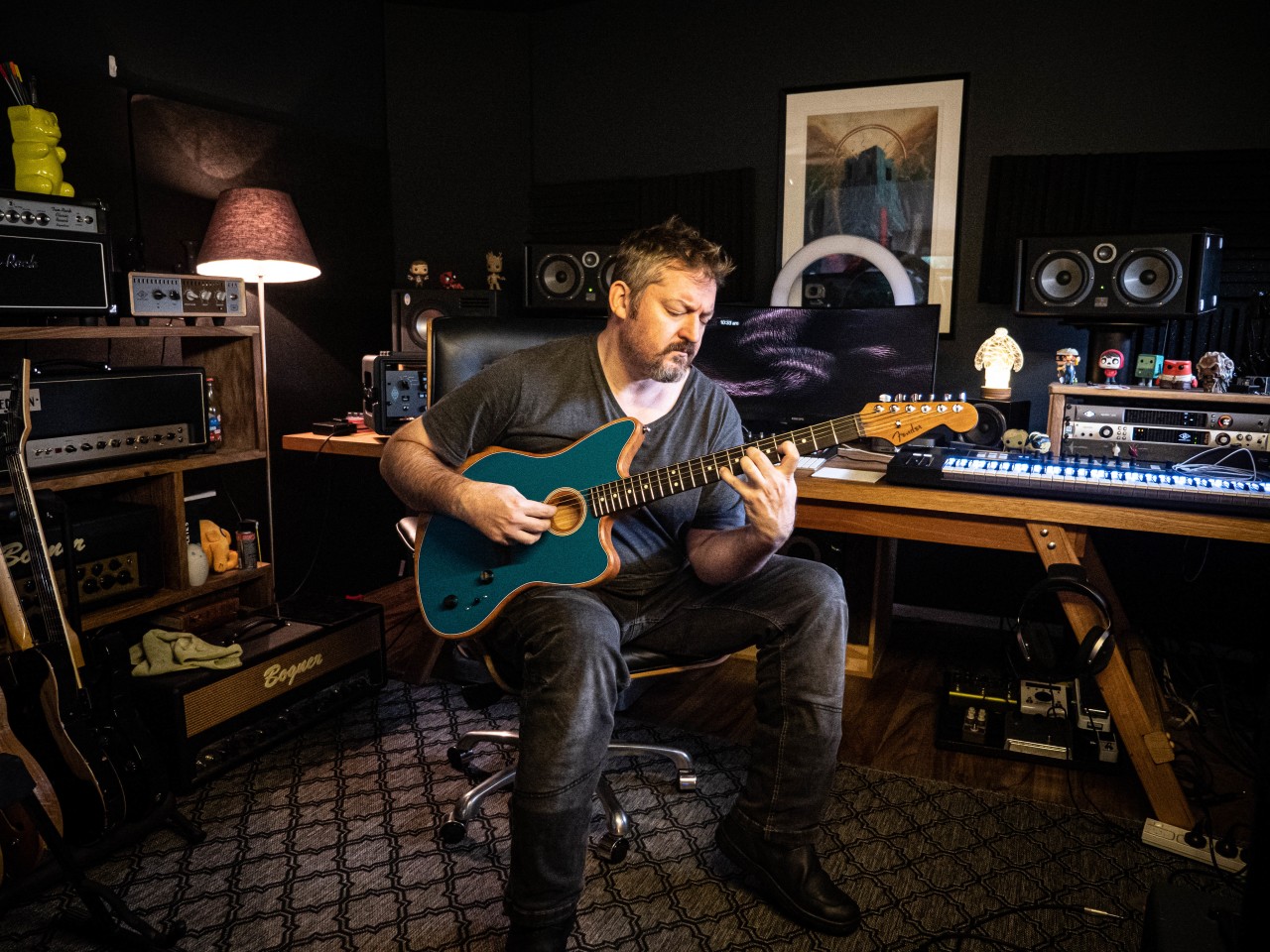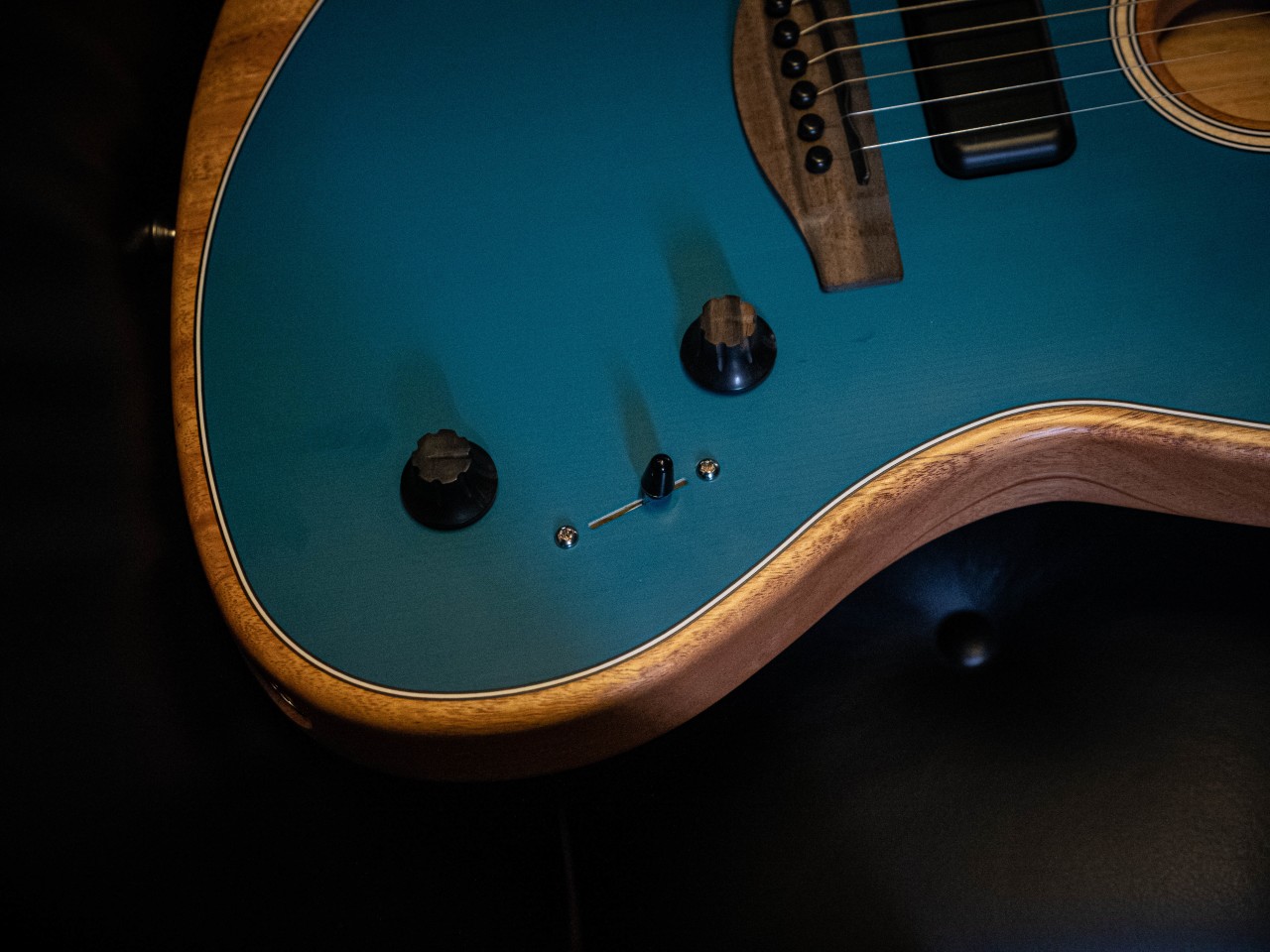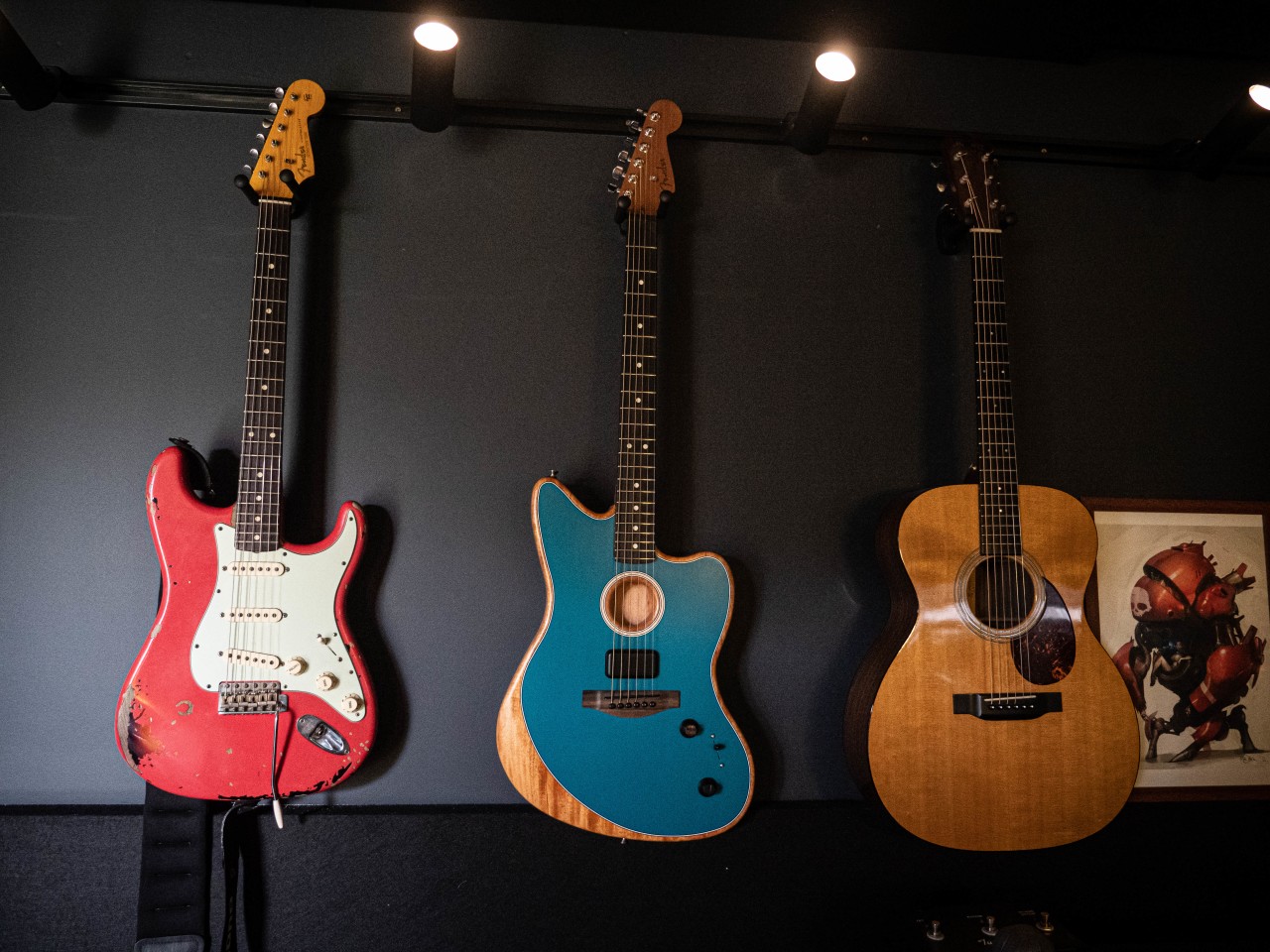The Acoustasonic series started out as Fender’s moon shot at re-inventing the acoustic guitar for the modern age, but its ambitions quickly expanded to become much broader. Equipped with three different types of pickup and a built-in digital signal processor, these next-generation guitars let you flip through 10 different sounds, acoustic and electric, before you even touch your toe to a pedal.
The first Acoustasonic launched in 2019, named and modeled after the iconic Telecaster. That was followed up with an Acoustasonic Stratocaster in 2020, and now for 2021 we see the weirdo wild child of the Fender electric lineup get its own version with the new Acoustasonic Jazzmaster.
There’s a cute little full circle being completed here: the original Jazzmaster was designed back in the late 50s to be an axe that might tear the jazz guys away from their hollow-bodied Gretches and so forth, but it didn’t really find its feet until it was adopted by surf-rockers, eventually building a reputation as the “alternative” guitar in the Fender catalogue with its rowdy, slightly unhinged character.
Now, its art deco rocketship shape is being re-incarnated as the very thing it was born to supplant: a hollow-body. Of course, it’s a very different kind of hollow body – and the way the Acoustasonics work, it could really be just about any shape at all – but it’s a neat little tidbit.

Loz Blain/New Atlas
The Acoustasonic Jazzmaster comes in five different colors, but none of them, even the starburst and the natural finish, want to look like a regular guitar. Our test unit, as you can see, came in a lurid shade of “Ocean Turquoise” with rather a linoleum kind of vibe to it. This, and its shape, quickly earned it the nickname “Gumby.”
Picking it up, it’s extraordinarily light. The all-mahogany body is more or less as thin as an electric, and it’s more comfortable than an acoustic to play, whether seated or standing. What’s more, its ebony fingerboard is slim with a generous cutaway at the bottom, giving you easy access to the upper frets that would have you straining on most acoustics. The action is electric-low, making it easy to play – although it comes standard with acoustic strings, so you need some extra muscle on a bend. The overall quality feel is well and truly up to Fender’s usual standards.
The built-in digital signal processor turns itself on when you plug the guitar in, and it’s got roughly 20 hours’ worth of battery, chargeable via a microUSB port. Making sure your guitar is charged is definitely an annoyance, and opens up the possibility of forgetting to top it up before a gig. Indeed, the fact that the battery lasts so long, and there’s no quick visual way of checking how much juice it’s got, makes it seem a virtual certainty to us that people will run out at inconvenient times, or leave it plugged in overnight and run it flat. Still, I’d tend to agree with the Fender design team that a battery level monitor or an on/off switch would kill the vibe and make this thing feel like more science experiment than guitar.

Cory Jach/New Atlas
Fender very much wanted to avoid that, and has designed it to be a guitar first and foremost, with the digital stuff hidden away and far from the focus. So we’re pleased to find this digital powerhouse is fun to play unplugged, much quieter than a traditional acoustic but it gives you enough to work with. You won’t annoy your family too much noodling away on the sofa while everyone’s watching TV, and you won’t be that guy everyone has to move away from at a party. It’s a humble, friendly, somewhat plunky instrument with the lead out.
Plug it in, however, and it’s a different beast altogether – well, several different beasts. The Acoustasonic system scoops up the acoustic sound of the guitar with a Fishman piezoelectric pickup, the movement of the mahogany body with a body sensor, also by Fishman, and it runs a Tim Shaw electric humbucker pickup back in the bridge position as well, specially designed for the Acoustasonic range.
These three inputs feed into the guitar’s brain, where they’re processed to bring out an impressive range of sounds. The five-position switch gives you access to two different sounds at each position, each at either end of what would normally be the tone knob, so you can roll through that knob for a blend of the two.

Loz Blain/New Atlas
At position 5 with the knob fully turned to the A position, it runs a sound designed to feel like a rosewood dreadnought. At 5B, a mahogany slope shoulder. 4A gives you a mahogany jumbo with a punchy tone that can almost verge on lap steel at times, 4B is an all-mahogany small body.
3A is a rosewood auditorium guitar, 3B gives you a pure output from the body sensor so you can get body slaps and thumps into your loop machine. 2A is a lo-fi piezo sound, 2B is the same but with some added gain for a crunchy, rowdy, aggressive acoustic sound. 1A goes for a Fender electric semi-clean sound, and 1B gives you an overdriven electric sound to rock out with.
The two electric sounds are complete with amp and cabinet modeling, so you can run the guitar straight into a PA system to take advantage of its full frequency range speakers. But you could run it through an electric guitar amp just the same, or indeed plug the thing into an A/B split box and run separate acoustic and electric channels.
I’m no tone master, but I do know a fella who is, so I immediately sought his opinion. I’ve been admiring Cory Jach’s work for nearly 25 years at this point; we used to play in cover bands together back when I called myself a drummer, but he’s gone on to make a go of the whole music thing as I spun off in different directions. He’s spent decades gigging locally, touring with Australian and international acts (Lionel Ritchie and the Pussycat Dolls come to mind), and building up a production and recording portfolio.
Like most every musician I know, he’s had about a year’s worth of downtime at this point, so I gave him the Acoustasonic Jazzmaster and asked him to record some demos of the sounds that appealed to him, figure out what he might use it for, and make a call on whether this digitally-enhanced hybrid can cut the mustard in a professional context as a live stage instrument.
To get a sense of the latter, we recorded two passes of a pretty similar looping tune, one with the Acoustasonic on Cory’s preferred 5A mahogany dreadnought position and another on one of his go-to stage acoustics, a Maton 808. The Maton might sound nicer in a room, but what about through its pickup? Both guitars ran through the same looper and pedal board into an audio interface running straight into Pro Tools. I’ve chopped the two tracks up so you can hear the two guitars back to back to back.
Fender Acoustasonic Jazzmaster vs Maton 808: Live Sound
I think it’s fair to say we were both surprised by the results. As well as being lighter, more comfortable and easier to play, particularly higher up the neck, it produces a very serviceable digitally enhanced acoustic tone that holds its own against a plugged-in Maton, although it’s a little more dynamically spiky on louder accents.
Would he take it out on a gig? Absolutely, on the strength of that dreadnought sound alone. The position 3B body sensor setting makes slaps and thumps sound every bit as good as they do through the full acoustic, and it also picks up plenty of deep bass, which comes in handy in a looping setup where an octave pedal can bring out more of that low end.
The position 2 piezo stuff wasn’t up his alley at all, but I can see who would like it; those harsh, crazed, crunchy electro-acoustic settings have a manic, messy feel to them that might go over well in an alternative/punky vibe. And while we didn’t pick either of these up on tape, the position 4A mahogany jumbo sound had a weirdly plunky attack to it that almost hinted in the direction of a dobro.
The electric sounds… Well, let’s put it this way. The Acoustasonic shines as an acoustic. The electric sounds are nice to have on the dial, and probably a handy little bonus offering some mild rock-out capability on an acoustic gig. The Jazzmaster pushes things harder than the electric sounds on the previous Acoustasonics, but you won’t be leaving your electric at home. It just doesn’t open up or sustain like a full electric. You can improve things by running it through a full electric rig, or an emulator setup, but then the built-in amp emulation and overdrive starts getting in the way.
In essence, don’t expect these things to rival the iconic tones of a Telecaster, a Stratocaster or a Jazzmaster electric just because they’ve got the same names and rough body shapes; they are their own thing.
Here’s Cory with some more sounds, including the electrics toward the end.
Acoustasonic Jazzmaster demo: Cory Jach
And that’s fine; it doesn’t have to be one axe to rule them all. As an instrument it’s designed to offer flexibility and convenience, playability and perhaps a spark of inspiration. We’d tend toward ranking it as an enthusiast level guitar, but then that dreadnought sound is so well done and it’s so comfy and light and nice to play that it does become a genuine replacement for a stage acoustic at a pro level.
It’ll be interesting to see how such an unconventional guitar is received on stage. Music is such a fashion game, and acoustic guitars are an iconic part of the look that sells certain songs and artists. The whole thing goes together as a package; people hear with their eyes to a certain degree and these Acoustasonics definitely don’t look like they sound.
But they do mark the start of a new chapter for Fender, and for guitars in general. While many guitarists still fetishize the old gear and wouldn’t dream of buying one with a computer in it, others are embracing the possibilities of the digital age. Amp and effect emulators are showing up on stages and in studios, where their ability to skip between wildly different sounds at the touch of a button offers enormous flexibility. They’re getting better every year.
Indeed, the presence of a USB port on the Jazzmaster Acoustasonic holds the promise of future updates. I think Fender would be mad if it didn’t start selling artist collection downloads of new sounds that could replace various patches on the guitar so that every player can have 10 sounds they really love on there. I think Fender should offer a capability to tweak and design those sounds – perhaps locked away at a higher-priced level targeted at pro players who will be less likely to stuff things up.

Loz Blain/New Atlas
We spoke to Fender’s head of R&D, Brian Swerdfeger, in an interview we’ll publish in full over the coming days. He told us he sees this generation of Acoustasonics as a transitional model, the one that people will look back and say was the first Fender to step into the digital age. It’s certainly a bold new approach, with a bold, new look, and some very bold sounds, particularly in the case of this Jazzmaster.
I find it a fascinating instrument and a fun and inviting one to play. And I think it’s the kind of machine every guitarist should get their hands on, at the very least to get a sense for what’s coming.
The Jazzmaster Acoustasonic ain’t cheap: US$1,999 or AUD$3,999 in Australia makes it very much a premium instrument. On the other hand, it’s a cutting-edge machine that goes further than anything before it in dancing a line between acoustic and digital, and offering a very diverse range of sounds from a single guitar.
Fender has gone out on a limb with this project, where as the company points out, it could very easily have sat back and built Strats and Teles with new paint jobs until the cows came home. The market might not have demanded this innovation – the market would probably say all it wants is an endless supply of beat-up 1965 Strats – but once people get their heads around what the latest Acoustasonic can do, some light bulbs are going to start turning on.
Source: Fender
Source of Article